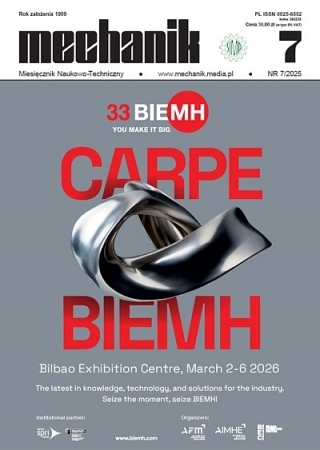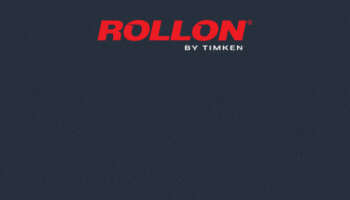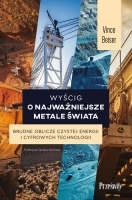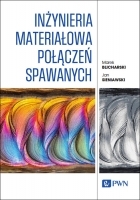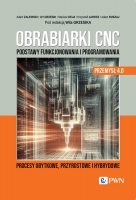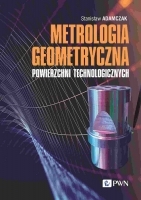Vibration analysis of a turning tool with passive damping
Analiza drgań noża tokarskiego z tłumieniem pasywnym *
Mechanik nr 10/2022 - Obróbka skrawaniem
ABSTRACT: Mechanical vibrations generated during machining can cause many problems in production processes. Vibrations can cause high dynamic loads leading to damage of the machine spindle, the cutting tool or the workpiece. Another unwanted effect of the existence of vibration during the machining process can be a deterioration in the quality of the machined surface. In this paper, a comparative analysis was carried out based on studies of the face turning process with conventional knives and those equipped with passive vibration damping systems. The results show the influence of the implemented vibration damper on the cutting process.
KEYWORDS: vibrations, machining, turning, vibration damping, MES simulations
STRESZCZENIE: Drgania mechaniczne pojawiające się podczas obróbki skrawaniem mogą być przyczyną występowania wielu problemów w procesach produkcyjnych. Drgania mogą powodować duże obciążenia dynamiczne prowadzące do uszkodzenia wrzeciona obrabiarki, narzędzia skrawającego lub przedmiotu obrabianego. Innym niepożądanym efektem występowania drgań w czasie procesu obróbki mechanicznej może być pogorszenie jakości obrabianej powierzchni. W niniejszej pracy przeprowadzono analizę porównawczą na podstawie badań procesu toczenia czołowego powierzchni nożami konwencjonalnymi i wyposażonymi w pasywne systemy tłumienia drgań. Wyniki badań przedstawiają wpływ zastosowanego tłumika drgań na przebieg procesu skrawania.
SŁOWA KLUCZOWE: drgania, obróbka skrawaniem, toczenie, tłumienie drgań, symulacje MES
BIBLIOGRAFIA / BIBLIOGRAPHY:
[1] He C.L., Zong W.J., Zhang J.J. “Influencing factors and theoretical modeling methods of surface roughness in turning process: State-of-the-art”. International Journal of Machine Tools and Manufacture. 129 (2018): 15–26, https://doi.org/10.1016/j.ijmachtools.2018.02.001.
[2] Benardos P.G., Vosniakos G.-C. “Predicting surface roughness in machining: A review”. International Journal of Machine Tools and Manufacture. 43, 8 (2003): 833–844, https://doi.org/10.1016/S0890-6955(03)00059-2.
[3] Gourc E., Seguy S., Michon G., Berlioz A., Mann B.P. “Quenching chatter instability in turning process with a vibro-impact nonlinear energy sink”. Journal of Sound and Vibration. 355 (2015): 392–406, https://doi.org/10.1016/j.jsv.2015.06.025.
[4] Kurata Y., Merdol S.D., Altintas Y., Suzuki N., Shamoto E.“Chatter stability in turning and milling with in processidentified process damping”. JAMDSM. 4, 6 (2010): 1107–1118, https://doi.org/10.1299/jamdsm.4.1107.
[5] Skrzyniarz M., Nowakowski L., Miko E., Borkowski K. “Influence of relative displacement on surface roughness inlongitudinal turning of X37CrMoV5-1 steel”. Materials (Basel, Switzerland). 14, 5 (2021), https://doi.org/10.3390/ma14051317.
[6] Skrzyniarz M., Nowakowski Ł., Miko E. “Development of a measurement method of relative displacements of the tool and the workpiece during turning”. Mechanik. 8–9(2015): 728/577–728/585, https://doi.org/10.17814/mechanik.2015.8-9.470.
[7] Paul P.S., Varadarajan A.S., Lawrance G. “Effect of material on damping characteristics of impact mass during hard turning”. Emerging Materials Research. 4, 1 (2015): 81–88, https://doi.org/10.1680/emr.15.00007.
[8] Habib G., Kerschen G., Stepan G. “Chatter mitigation usingthe nonlinear tuned vibration absorber”. International Journal of Non-Linear Mechanics. 91 (2017): 103–112, https://doi.org/10.1016/j.ijnonlinmec.2017.02.014.
[9] Quintana G., Ciurana J. “Chatter in machining processes: A review”. International Journal of Machine Tools and Manufacture. 51, 5 (2011): 363–376, https://doi.org/10.1016/j.ijmachtools.2011.01.001.
[10] Ema S., Marui E. “Damping characteristics of an impactdamper and its application”. International Journal of Machine Tools and Manufacture. 36, 3 (1996): 293–306, https://doi.org/10.1016/0890-6955(95)00073-9.
[11] Ema S., Marui E. “Suppression of chatter vibration of boring tools using impact dampers”. International Journal of Machine Tools and Manufacture. 40, 8 (2000): 1141–1156, https://doi.org/10.1016/S0890-6955(99)00119-4.
[12] Edhi E., Hoshi T. “Stabilization of high frequency chatter vibration in fine boring by friction damper”. Precision Engineering. 25, 3 (2001): 224–234, https://doi.org/10.1016/S0141-6359%2801%2900074-5.
[13] Mei D., Kong T., Shih A.J., Chen Z. “Magnetorheological fluid-controlled boring bar for chatter suppression”. Journal of Materials Processing Technology. 209, 4 (2009): 1861–1870, https://doi.org/10.1016/j.jmatprotec.2008.04.037.
[14] Orečný M., Segľa Š., Huňady R., Ferková Ž. “Application ofa magneto-rheological damper and a dynamic absorber for a suspension of a working machine seat”. Procedia Engineering. 96 (2014): 338–344, https://doi.org/10.1016/j.proeng.2014.12.127.
[15] Senthil Kumar M., Mohanasundaram K.M., Sathishkumar B. “A case study on vibration control in a boring bar usingparticle damping”. Int. J. Eng. Sci. Tech. 3, 8 (2012): 177–184, https://doi.org/10.4314/ijest.v3i8.15.
[16] Fisher X., Coutellier D. “Research in interactive design”. Paris: Springer-Verlag (2006).
DOI: https://doi.org/10.17814/mechanik.2022.10.19
* Artykuł recenzowany




